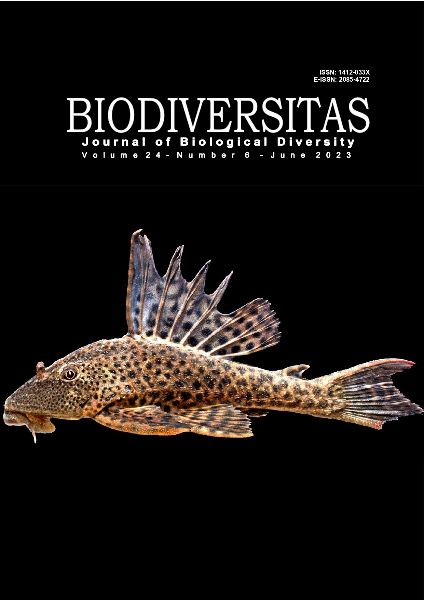Morphological relationships and cross compatibility of seven Dendrobium species in Indonesia
##plugins.themes.bootstrap3.article.main##
Abstract
Abstract. Lestari NKD, Deswiniyanti NW, Sari NKY, Murna IM, Rizqy AN. 2023. Morphological relationships and cross compatibility of seven Dendrobium species in Indonesia. Biodiversitas 24: 3550-3558. The development of Dendrobium hybrid orchids in Indonesia has received less attention. This study aimed to obtain the morphological characteristics and taxonomical relationships of Dendrobium species, their interspecific and intersectional compatibility for hybridization, as well as the fertility of hybridized Dendrobium orchids. Seven Dendrobium species from several sections were used, namely D. phalaenopsis, D. lineale, D. stratiotes, D. macrophyllum, D. nobile, D. heterocarpum and D. bracteosum. We characterized the seven species based on morphological traits and investigated the taxonomical relationships using hierarchical cluster analysis by dendrogram charts. We then crossed the seven species to produce hybrids and the hybrids were then cultured in vitro. The hybridization and in vitro culture data were analyzed using an ANOVA test with Duncan's post hoc test when the results significantly differed. The results showed that the taxonomical relationship was clustered based on the sections of each Dendrobium species. The highest percentage of hybridization compatibility was found in D. phalaenopsis and D. lineale with 61.9% while the lowest was in D. nobile, and D. bracteosum (0%). Germination percentages in in vitro culture ranged from 40% to 100% for both interspecific and intersectional crosses, except for intersectional crosses of D. nobile, which failed to germinate. The findings of this study suggest that the results of interspecies and intersectional crossing showed that the highest compatibility was indicated by D. phalaenopsis and D. lineale. Therefore, they are highly recommended as the parents of hybrid orchids.
##plugins.themes.bootstrap3.article.details##
Most read articles by the same author(s)
- I GEDE WIDHIANTARA, I MADE WISNU ADHI PUTRA, NI KADEK DWIPAYANI LESTARI, PUTU ANGGA WIRADANA, ANAK AGUNG AYU PUTRI PERMATASARI, NI KADEK YUNITA SARI, NI PUTU LIDYA WINDARISTA, GLADYS ELIZABETH, TEGUH HARI SUCIPTO, Ethnopharmacological study of medicinal plants used on usadha rare remedies in Bali Province, Indonesia , Biodiversitas Journal of Biological Diversity: Vol. 25 No. 12 (2024)

